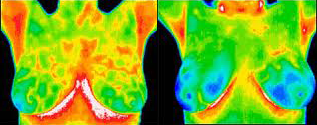Sherrill's Articles
Breast Thermography – Seeing the Future
The most widely promoted screening method for breast cancer is mammography. However, this technology is not without dangers, primarily, the cumulative radiation exposure is damaging to the DNA. Mammography is not a particularly effective or a safe diagnostic tool. Its shortcomings include the tendency for false readings and its inability to reveal unfavorable conditions when a breast lump is not present.
Fortunately, there is another option. It is called Digital Infrared Thermography (DIT) and is painless, non-toxic and highly accurate. It can safely be used to screen young women.

Although you may have never heard of it, it has actually been used for over 30 years. In fact, over 80 peer-reviewed studies have proven its effectiveness. It is also FDAapproved for the use in breast cancer screening. DIT requires neither radiation nor breast compression. As a diagnostic tool, it has the ability to detect breast irregularities and possible “hot spots” years before they would ever be revealed with mammography or breast exam. Thermography uses ultra-sensitive, high-resolution digital infrared technology.
It is able to measure subtle changes in the temperature at the surface of the body. When a cancer is forming it develops its own blood supply in order to feed it accelerated growth. Since cancerous tumors have this increased blood supply, they are slightly hotter than the surrounding area in which they are found. The increased blood supply causes an abnormal heat pattern in the breast. Thermography can detect this abnormal heat pattern by scanning the breasts with a specialized infrared camera. The information is then analyzed using sophisticated computer programs, which translate the data into anatomical images under the guidance of properly trained health professionals. The difference in body temperature is measurable, particularly when both breasts can be compared.
These abnormal heat patterns are among the earliest known signs of a potential cancer or inflammation. Any areas indicating increased heat can then be investigated further with a mammogram. Thermography measures physiology, unlike a mammogram, which detects changes in anatomy. Often the physiological changes precede the anatomical changes. An unprecedented level of early detection can be realized when thermography is added to a woman’s regular breast health care. It has been found an abnormal thermographic image is the single most important sign of high risk for developing breast cancer, eight times more significant than a first order family history of the disease.
Studies show DIT has the ability to warn woman of a developing cancer up to ten years before any other test. A tumor must grow to about the size of a small grape before it will block enough x-rays to create an image on the film. DIT is the only screening method available that detects angiogenesis (the process whereby a group of blood vessels are specifically formed by a tumor to supply it with nutrients and oxygen). Thermography has the ability to detect a tumor’s growth when its size may be no larger than the head of a pin. This gives breast Thermography the ability to detect cancer at its earliest and most treatable stage. It’s truly an early warning system for the future risk of breast cancer.
DIT especially benefits young women since the breast tissue is more susceptible to the damaging effect of radiation, Thermography offers a much safer and more effective, screening alternative. A positive infrared scan may indicate the presence of many different breast abnormalities such as mastitis, benign tumors, fibrocystic breast disease, cancer, and others. Just as unique as a fingerprint, each patient has a particular infrared map of her breasts. Any change in this infrared map in future imaging can indicate an early sign of an abnormality.
This technology has an important role in breast cancer prevention. Thermography has the added ability to observe the influence of hormones on the breasts. Research has determined the single greatest risk factor for the future development of breast cancer is lifetime exposure to estrogen. In which case controlling the influence of estrogen on breast tissue would be the single greatest method of breast cancer prevention. While thermography does not medically or legally replace mammography, it is certainly a valuable diagnostic tool.
Thermography has a unique role in the monitoring of a woman’s breast health, since it has the ability to detect a precancerous state of the breast, or signs of cancer at an extremely early stage. Although not as readily available as mammography, the awareness and access to digital thermography is growing.
Disclaimer: All material provided on this page is for informational or educational purposes only, and should not be construed as a substitute for medical advice. Please consult a qualified health practitioner regarding matters of personal wellbeing.
